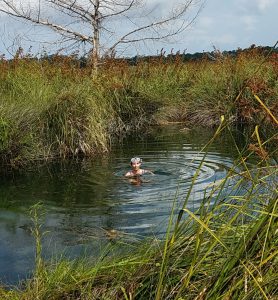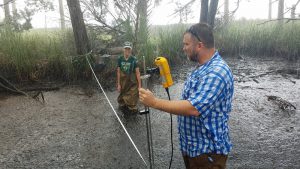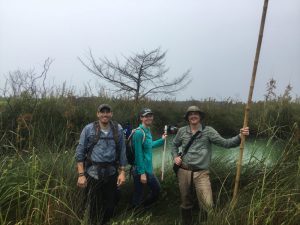NCBS Intern Report by Victoria Steinnecker, with Tom Mirti and Mark Hinz from the Suwannee River Water Management District
 This Summer
This Summer
I interned with Suwannee River Water Management District (SRWMD), and basically what that means is springs, because within the district’s’ boundaries is one of the highest concentrations of springs in the world. Springs are often recognized for their recreation, aesthetics, and historical relevance, but they also play a vital role in groundwater recharge, supplying freshwater, and microclimate regulation and biodiversity. Springs come in many shapes and sizes: some are big and blue and frequented by people; some are milky and smell of sulfur or are rust-colored from high iron; some have almost unnoticeable flow or are walled off by a historic bath-house structure; some have elaborate cave systems, and some flow right up into the ocean offshore!
My Main Research Project
To investigate the tidal impacts on coastal springs using a rapid deploy station and advanced sensor technology. Coastal springs tend to remote, mystical, and hard to access. On my first site evaluation day in the field, I stood on the bank of a thigh-high creek wearing my knee-high snake boots and realized it was time to get my feet wet as my team waited on the other side. Slipping and sinking through the salt marsh as you try  to make your way through needle rush and sawgrass (which are as mean as they sound) may not sound like a good time for some people, but I feel blessed that I got to get intimate with what I now know to be some of the most beautiful parts of Florida.
to make your way through needle rush and sawgrass (which are as mean as they sound) may not sound like a good time for some people, but I feel blessed that I got to get intimate with what I now know to be some of the most beautiful parts of Florida.
The Takeaway
Aside from all the muddy back-roads and fun field days, I did a lot of work and learned a lot too. I did some circuitry work while constructing my deploy station; I evaluated grab sample results for biota, nutrients, and metals; I used various methods to determine flow, including the “orange” method; I calibrated and operated YSI and UV sensors; I used R, Hydstra, and Excel to make graphics and evaluate data; I spent a lot of time figuring things out and getting rained on, and I drank a lot of coffee.
 I made a lot of great friends and have some cool stories to tell too. Thanks to everyone at the Nature Coast Biological Station and Suwannee River Water Management District for an awesome summer!
I made a lot of great friends and have some cool stories to tell too. Thanks to everyone at the Nature Coast Biological Station and Suwannee River Water Management District for an awesome summer!

 0
0
